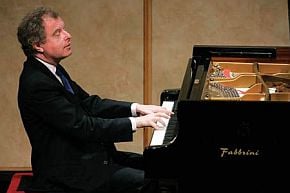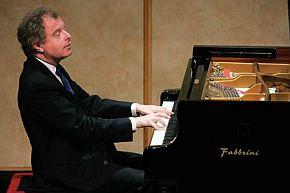
Listen to the Music
Locally, Jerry Kuderna played the entire series for his class at Diablo Valley College a year ago. Schiff and Angela Hewitt are in various stages of recording it. And for every pianist just named, there are two or three others who have embarked on the journey, not to mention the nonprofessionals who have studied the pieces and harbor the ambition to present them publicly.
What is it that compels us to repeatedly perform and listen to a corpus of works? From performers, to musicologists, to audiences and recording collectors, we lovers of classical music seem to have an obsession for completeness. Just this season in the Bay Area, we’ve witnessed complete performances of the Bach Well-Tempered Clavier; Brahms' violin sonatas, string quartets, and trios; half of a voyage through the complete Haydn string quartets; a complete Die schöne Müllerin, and two traversals of Schumann’s Dichterliebe, among others.
We curate classical music just the way that we do paintings and sculpture. Sometimes completeness testifies to the curator’s diligence and skill, so that the ability to play Bach’s entire WTC is like the ability to display all of Monet’s water lily paintings at once. A major retrospective portrays an artist’s work in a particular frame, sometimes accompanied by lectures and discussions, as with Joseph Horowitz’ recent parade of Stravinsky at Stanford.
From Completeness to Celebration
But when we get to Beethoven, our obsession with completeness becomes celebration, almost as if we were observing a rite within the larger cultural calendar. There are stories to tell in the piano sonatas, tales bound up in history and myth. Beethoven’s music limns the transition from the inherited traditions of the 18th century to 19th-century Romanticism. And Romanticism is still our musical baseline in most ways. Its emotional metaphors are the ones we respond to. With Beethoven, we generally stop talking about “early music.”
The Beethoven myth was engendered by his musical summer, the “heroic period,” a decade of astounding creativity extending, roughly, from 1802 to 1812. His expansion of the Viennese classical style into unprecedented territory also conveniently coincided with the tragic irony of his encroaching deafness. We persistently use this circumstance to explain the jolting drama of the most famous pieces of the period. And we also find, in a letter from Nov. 16, 1801, the determined, aggressive personality that overcame the loss: “Every day brings me nearer to the goal which I feel but cannot describe ... I will seize fate by the throat; it shall certainly not bend and crush me completely.”
If you wanted to read Beethoven’s musical biography, you would begin with the piano sonatas, as virtually all general histories of music do. Apart from the “Electoral” sonatas, composed in 1782-83, when the composer was 12, which are, unjustifiably, never considered part of the canon, the first 20 of the 32 sonatas were composed between late 1794 and 1802. They contain his first masterpieces and they provide the evidence for the musical transition we all care about.
Even the earliest of these works show a tension between the reigning style and the more personal, confident voice of a determined young man eager to distinguish himself. The virtuosic first sonata was obviously written to impress a crowd, and is fairly conventional. But you still find a lovely set of variations — a genre at which Beethoven always excelled — in the second movement. And the finale, with its incessant triplets, sharply contrasted dynamics, and concise thematic material, is already quintessentially “Beethovenian.”
The first movement of the second sonata, in A, is an experiment in motivic development. The second theme is a fragment of melody that begins in the minor key and goes through a harmonic sequence to reach E major. The development sets a pattern for wide-ranging modulation that is also typical. Beethoven titled Op. 7 “Grand Sonata,” highlighting its intricate design and half-hour length. Many of the themes feature repeated notes, another of the composer’s rhythmic thumbprints. The subtly shaded melancholy of the Largo e mesto (slow and sad) movement in Op. 10/3 beguiles the listener. And all of this happens before the famous “Pathetique” Sonata, Op. 13 (1797), the first masterpiece of this period.
Beethoven Unbound
Beethoven pushed boundaries from the beginning. The set of sonatas from 1800 to 1801 are self-consciously experimental, and play with the order and character of movements in the sonata cycle. Op. 26, in A-flat major (not a common key at the time), has a funeral-march second movement, and the Op. 27 pair have highly unconventional first movements (Op.27/2 is the famous “Moonlight” sonata), and both bear the qualifier “quasi una fantasia” in their titles. “Beethoven never repeats himself,” Jerry Kuderna once told me.
By this point in his career, a whole five years after his publication debut, Beethoven was marking each new work with a fresh approach. So how far did he have to jump to come up with the “Tempest” sonata, Op. 31/2, the first minted in the heroic style? The previous sonatas show us the style emerging from the composer’s musical personality. In 1800, Prince Karl Lichnowsky helped to make Beethoven financially independent with a generous yearly subsidy. If you’re looking for biographical facts that explain the sudden appearance of the symphonies and other large-scale projects, begin here.
With income pouring in from published compositions and concerts, Beethoven took the next step in his creative journey in relative security, despite the inner conflicts that beset him. The piano sonatas from 1804 to 1805 include a couple you may have encountered, the “Waldstein,” Op. 53, and the “Appassionata,” Op. 57, and one you may have missed, the short but vastly underrated Op. 54 in F major.
And then Beethoven took a break, concentrating on other genres. In the Napoleonic invasion year of 1809, he composed three more, including No. 26, the “Lebewohl” (Farewell) sonata in E-flat, Op. 81a. The sonata commemorates the flight, during the invasion, of another Beethoven patron, the Archduke Rudolph, and his subsequent return. Financial and personal troubles buffeted the composer in the later war years, and his creativity suffered. Op. 90, written in 1814, links Beethoven’s explosion of the sonata cycle in the heroic decade and the last group of five, which he composed between 1816 and 1822, after his recovery. The last five, as is often pointed out, increasingly mix fugue and contrapuntal writing into the formal models. And overall, there is a sense of “quasi una fantasia” to these works.
In the last movement of Op. 111, the theme nearly evaporates in the midst of an ecstatic trill in the piano’s topmost register. It seems a fitting endpost, except that — if we were totally honest — we would include the great Diabelli Variations (1824) in the series, given how important variations become in Beethoven’s later style. So performing the complete series of piano sonatas reenacts the arc of Beethoven’s career with a fair amount of detail. That explains why pianists like to confront them in chronological order. (Schiff has chosen this route, placing the Op. 49 sonatas, composed in the 1790s, with their fellows, instead of following the published order.)
In their tremendous variety and circumnavigational approach to form, the sonatas offer the performer an Olympics worth of technical challenges and interpretive possibilities. Pianists play most of them their whole lives, forming an intimate connection with the music. And as Kuderna reminded me, there aren’t all that many large bodies of piano music that engage an audience consistently throughout the multiple concerts required to achieve the summit of completion. “It’s both challenging and fun at the same time,” he says.
Close Encounters for the First Time
Many of Kuderna’s students had never heard a piano live and close up when he took them through the series. He remains amazed at the responses the music elicited. He remembers taking the tempo of the last movement of the “Waldstein” a little fast one day, because he was watching the clock. “And after class I asked some of them if it had seemed too fast, and a few kind of nodded in agreement. So with that I sat down and played the whole of the sonata again, and they stayed. That was the kind of relationship we developed. They were truly involved and engaged. And what more do you want?”
Audiences intuit a lot of information from Beethoven’s sonatas, and that connection between performer and audience is what turns these concert series into the minifestivals they are. Kuderna shared with me a student’s description of the Diabelli Variations written immediately after his performance:
You’re right, it starts off very humorous and jolly. ... As the variations move along, each one is a bit serious. It’s almost as though a man, who everyone knows is a joker, is, for once, trying to be serious. He wants people to see him in a different light, but still no one can really take him seriously, or know for sure that he’s really being serious.Many of the students in Kuderna’s class are children of immigrants or first-generation Americans, from widely diverse backgrounds, and all of them were able to grasp the essentials of the music. For musicians, experiencing this kind of communion, where you can translate the endless details you think about in private and in rehearsal into music that speaks to genuine, lived experience, yours and the audience’s, is the reason for living. From the success of one series, musicians branch out, seeking the same experience in other complete series with similar breadth. (Mahler symphonies come to mind.) Like so much else, we owe our curatorial urge to the impact of Beethoven’s music.

